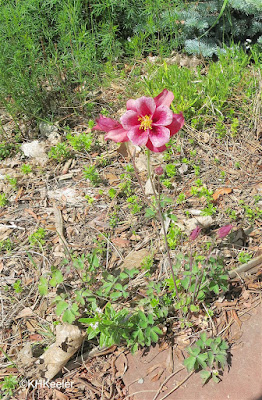 |
| Rocky Mountain columbine, Aquilegia coerulea |
Columbines (genus Aquilegia, buttercup family, Ranunculaceae) are so widely grown as to seem cliché but, although there are many Eurasian species, the ones grown in the U.S. are largely native American species. My top photo is the Rocky Mountain columbine, Aquilegia coeralea. Western North America has blue, purple, yellow, and white flowered species, in addition to red-and-yellow-flowered ones, similar to but different from the columbine of eastern North America, Aquilegia canadensis. Planted together in gardens, many will hybridize, leading to even greater diversity of color and shape. I love them. In my garden they are one of the few plants allowed to break the "no plants in the paths" rule. I am hoping, though, that they will migrate around the yard until they find a flowerbed they really like, at which point I will enforce the "no plants in the paths" rule. Right now I don't have as many as I want so I let them grow where they will.
 |
| columbine, Aquilegia |
 |
| blue flax, Linum lewisii |
Also really neat are the larkspurs (Delphinium species, buttercup family, Ranunculaceae).
 |
| blue larkspurs, Delphinium species |
As you see, I have a tiny "prairie" in my yard, where I started the native wildflowers, rather than in a garden bed, but, though my photos don't show it, they routinely seed into my more traditional flowerbeds.
Other regions of North America have spectacular spring flowers that are often grown in gardens but most do not survive long in my northern Colorado's climate (hot and dry in summer, cold and dry in winter, changing temperature suddenly). Enjoy, for example, trilliums (Trillium spp.), camellias (Camellia spp.) and magnolias (Magnolia spp.) if you can grow them.
The first of my native geraniums is flowering. They were on the property when I bought it and a quick attempt to identify the flower to species did not turn up a clear match, so this is a geranium, genus Geranium (family Geraniaceae), an American wildflower whatever species it is.
 |
| wild geranium, Geranium |
 |
Western wallflower, Erysimum asperum
|
 |
| serviceberry, Amelanchier alnifolia |
 |
| redbud, Cercis canadensis |
Our last killing frost or six-inch snow can happen as late the middle of May. Consequently the native plants do not flower nearly as early as the introduced garden plants: if a garden plant is killed by the cold, gardeners buy another. Wild plants are on their own and they have survived by adapting to the climate, for example, staying dormant longer.
There will be a big outburst of flowering in early June. Coming soon, Missouri evening primrose, Oenothera missouriensis (evening primrose family, Onagraceae). They open in the night, stay open through the morning.
 |
| The garden sage (Salvia officinalis) was all green before the May 9th frost. |
 |
| Missouri evening primrose, Oenothera missouriensis |
 |
| blanketflower, Gaillardia |
I am enjoying those now in bloom and will appreciate the others as they appear. Happy Spring!
Comments and corrections welcome.
Comments and corrections welcome.
Blog posts on some of the flowers mentioned here:
columbine Colorful Columbines link
delphinium The Dramatic Larkspurs link
geranium - Wild Geraniums, A Treat to See link
serviceberry- Flowering Shrub of Spring link
redbud - The Striking Eastern Redbud link
garden sage - Plant Confusions: Sage and Sagebrush are Different link
evening primroses - Evening Primroses, Beautiful Wherever You Meet Them link
blanket flower - Beautiful Blanket Flower link
Kathy Keeler, A Wandering Botanist
More at awanderingbotanist.com
Post Script: Winter won't stop this year. May 21st snow. The native plants are saying "we told you it happens!"

Fabulous wildflowers!
ReplyDelete